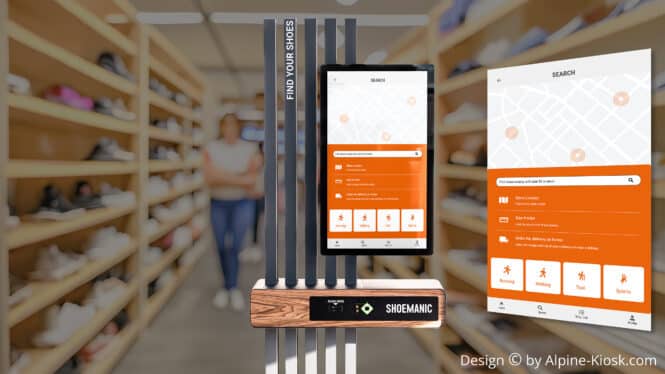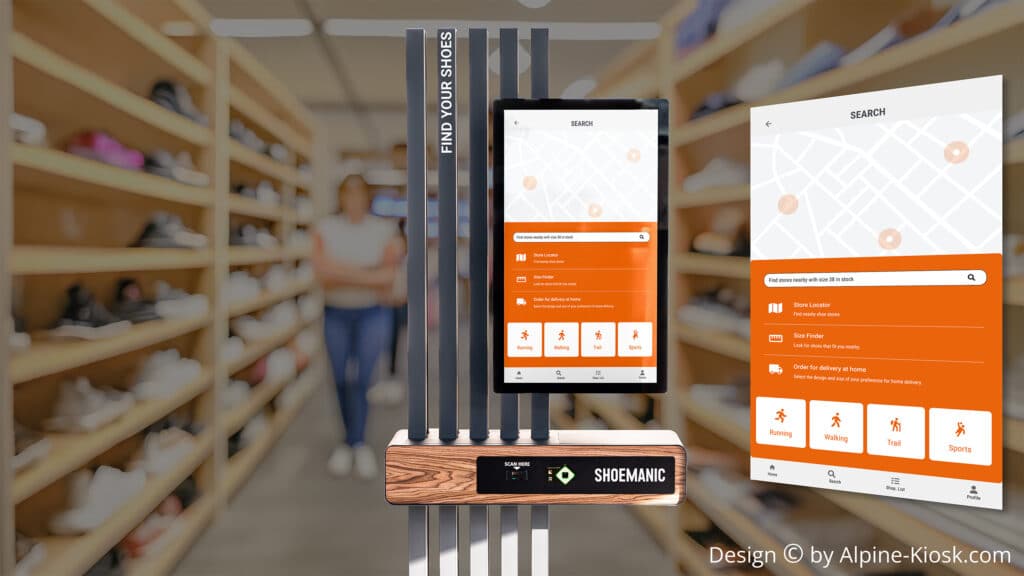
If The Shoe Fits, then buy it!
How easy is it to find the shoe size 12 (46 EU) or larger? The answer is “It Depends”
About the Writer: Christoph Nussbaumer is the CEO of REINGroup based in Austria. Alpine Kiosk boasts a diverse array of designs, each is highly adaptive and radiating elegance and sophistication. Alpine Kiosk – Where each design is a testament to premium craftsmanship. Alpine Kiosk is Gold Supporter of Kiosk Industry Group and member of the KMA Kiosk Association. His viewpoint from Europe and US is invaluable.
Previously we discussed “machine vs. human in fast food restaurants”. Today let’s explore service in shoe retail.
An Unplanned Experiment in Shoe Shopping
Are we talking about shopping online or in-store? Which region are we discussing? USA, EU, Asia…? Male or female?
As a male shopping for shoes in the USA or Central Europe, I can tell you that most of the time I walk out of the store empty-handed.
Even when I do find a pair, it’s often not the one I initially liked. The question is why? Am I the only one?
Last week I needed new business shoes. I usually shop online, but for shoes, I have to try them on and walk a few steps.
Honestly, I’m too lazy to order multiple pairs, try them on, pack them up, label them, and send them back. It’s just too much hassle.
I like to get a purchase done in under 5 minutes: walk into the store, choose my favorite pair, try them on, walk a few steps, pay, and leave.
During my last visit to the store, I found a nice pair but not my size on the shelf. I walked around looking for a staff member. They were busy, so I waited. Finally, I asked, and she checked, saying, “Sorry, we don’t have it.” I found another pair and looked for help again. After waiting, she checked the system and said my size was at a store 10 miles away.
Two tries, no results. It made me think about how much time we waste on simple things.
I missed the online shopping experience: set a filter to size 12-13 (46 EU), hit the button, and see all that’s available.
Data Insights: Online vs. Offline
Online Returns: Online shoe return rates can be 35-40%, sometimes reaching 50% because customers can’t try shoes on before buying. (Footwearmagazine)
Offline Returns: Physical stores have a lower return rate of 8-10% as customers can try on shoes. (Markinblog)
Why Do People Return Shoes?
- Fit Issues: Fit problems cause 65% of returns
- Product Mismatch: Items not matching descriptions or arriving damaged
- Bracketing: Buying multiple sizes to ensure fit increases returns (Digital Commerce 360).
Retail Kiosks Conclusion
The difference between online and offline shopping highlights a major opportunity for offline retailers. Customers value in-store fit feedback but go online for convenience and selection. To maximize benefits, stores should provide real-time inventory checks, a wide range of products, and easy ordering for out-of-stock items.
Questions for the Consumer
- How often do you struggle to find your shoe size in-store?
- Have you ever had to visit multiple stores to find your size?
- Would real-time inventory information in-store improve your shopping experience?
- How useful would it be to know instantly if a nearby store has your size?
- How often and how long do you wait for an employee to check for your size?
- How many times have you left a store empty-handed because your size wasn’t available?
Questions for the Store Owner
- How much time do your staff spend checking shoe sizes and availability for customers?
- How do you currently ensure all sizes are available for customers in-store?
- What steps do you take to keep customers from leaving due to out-of-stock sizes?
- How often do customers leave your store without buying because their size isn’t available?
- How many customers leave your store daily without making a purchase? Why? Did they search for a size or a model? You don’t know, right?
Service in the Moment: Human vs. Machine
What I asked myself: How often would a customer ask for size availability, wait for staff to check, just to hear it’s not available, and choose another model?
How many just take a picture, leave, and order online at another place?
The Role of Technology: Enhancing Customer Support
If I imagined there was a prominently placed self-service kiosk with a large interface in the store, I could walk there, scan the box of shoes, and get real-time information such as:
- Is my size available here?
- Is my size available in nearby stores?
- Which similar models are available?
- Detailed information about this shoe (collection, materials, usage, etc.)
- If only available online: order and pay directly, get delivered to my home.
The Benefits for Store Owners and Customers
All of this would have happened without any waiting time. The store would not have lost my business.
Concluding Thoughts: A Synergy of Service
Am I saying: Self-service wins in this case?
No, not at all. But it takes away simple standard jobs from the employees, making them even more efficient. They can focus more on customers who need real human interaction and support or who are not as tech-savvy.
There is no winner, but some services can be handled better by a kiosk, and some by a human being.
This brings up questions for the store owner:
- How much could sales increase if every size was always available?
- If there were no more waiting lines?
- If no more customers walked out because they could order directly from your online store (store-in-store concept)?
A Look Forward: Incorporating Technology for Enhanced Retail Experiences
Furthermore, think about the data insights:
- most popular models
- sizes
- lookups but no purchase, why?
- And many more in real-time.
Now there might be voices in the industry saying: we tried it and failed.
The question is why did they fail? Was there any analysis?
I once visited a US sports retail chain with a large sports shoe department. The digital support they offered was a tiny tablet on a stick with a bad UI.
I hate looking down and scrolling on my small phone screen when in a store to research something. Why should I do it with a device on low height and a tiny screen in the store?
A huge screen with generous room for a nice presentation of the product and information I want, that’s what attracts me.
Furthermore, if it is designed in an attractive way that fits with the store environment. Neither a tablet on a stick nor an antiquated ATM-like machine attracts me there.
Have you experienced challenges finding your shoe size? Share your thoughts on how technology could improve your shopping experience!
► CONTACT US:
Alpine Kiosk – Elevating the world of self-service through unparalleled design and innovation.
At Alpine Kiosk, we redefine self-service through design and versatility. Our core philosophy is to harmonize stunning aesthetics with unparalleled modularity, ensuring that our kiosks are visually captivating and adaptable to any setting and requirement. Stay connected with us on our social media channels for the latest updates and insights into the evolving world of kiosk design.
► FIND US HERE:
► Website: Custom Self-Service Kiosks for Multiple Industries | Alpine Kiosk
► YouTube: Alpine Kiosk
► LinkedIn: https://www.linkedin.com/company/alpine-kiosk
Related Links
Post Article Summary
- Offline vs. Online Shopping:
- Online shoe return rates can be as high as 35-40% due to fit issues, as customers can’t try shoes on before buying.
- Physical stores have a lower return rate of 8-10% because customers can try on shoes in-store.
- Challenges in In-Store Shopping:
- Finding the right shoe size in-store can be time-consuming.
- Customers may visit multiple stores to find their size
- Waiting for staff to check availability can lead to frustration.
- Technology Solutions:
- Self-service kiosks with real-time inventory information can enhance the in-store experience
- Kiosks can provide details about size availability, nearby stores, and similar models.
- Store owners should focus on maximizing benefits by ensuring all sizes are available and reducing waiting times.
- Synergy of Service:
- Both self-service kiosks and human interaction have their place.
- Kiosks handle routine tasks efficiently, allowing staff to focus on personalized service.
Sense of Humor
Yes we have one.


